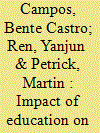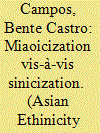| Srl | Item |
| 1 |
ID:
149773


|
|
|
|
|
| Summary/Abstract |
This article analyzes the impact of education on income inequality between ethnic minorities and Han in China by using the data from the China Health and Nutrition Survey (CHNS) over the period 1993–2011. An instrumental variable approach using two institutional changes is applied to address the endogeneity of education in income equations for various subsamples. To investigate the impact of education on income inequality between ethnic minorities and Han, we introduce an interaction term between the ethnic minority status and years of education. Our results suggest that there exists significant income inequality to the disadvantage of ethnic minorities for the full, female, and urban samples, and depending on the instrument also for the rural sample. Nevertheless, our results for these samples show specific returns to education for ethnic minorities, which implies that a portion of the income gap can be overcome with additional education. We find that in general one additional year of education will increase earned incomes of ethnic minorities by 26.3–28% and in particular by 13.5–14.4% for women from an ethnic minority group, by 10.4–14% for ethnic minorities with urban household registration, and by 10.8% for ethnic minorities with rural household registration. However, we cannot obtain conclusive results for the male sample due to weak instruments.
|
|
|
|
|
|
|
|
|
|
|
|
|
|
|
|
| 2 |
ID:
141161


|
|
|
|
|
| Summary/Abstract |
This article studies the Miao classification as an example to examine the minzu shibie project initiated by the Chinese Communist Party after 1949. The Miao classification that originates with the minzu shibie project can be defined as a process of miaoicization; however, it is not a unified Miao group (as projected by the classification team) that has emerged but rather one dominant Miao subgroup that defines the official Miao category in contemporary China. At the moment the most dominant Miao subgroup is the Hmu group in Southeast Guizhou. The overemphasis of Hmu sub-culture to represent all the Miao of China is related to the fact that over the last decades many important leaders in Guizhou have been Hmu. While all Hmu are sinicized to a certain extent, it seems that the Hmu at the bottom of the socioeconomic scale are most likely to be sinicized and to amalgamate with the Han majority.
|
|
|
|
|
|
|
|
|
|
|
|
|
|
|
|